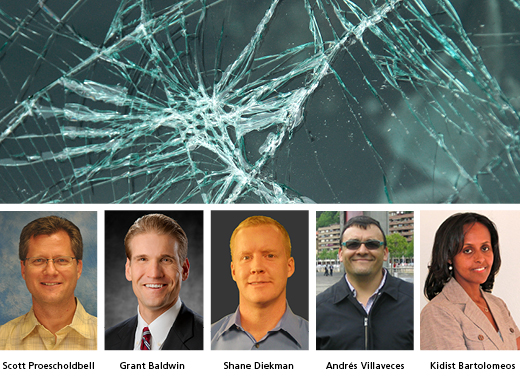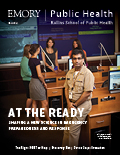Common Cause
From Georgia to Geneva to North Carolina, five classmates share a mission to prevent injuries and violence
Grant Baldwin 96MPH and Andrés Villaveces 96MPH first met when they were young children and their fathers worked together in Colombia. Today, their lives still converge, along with those of three Rollins classmates who are experts in injury and violence prevention and control.
In the early 1990s, Villaveces was a physician in Colombia, where the incidence of trauma caused by traffic injuries and violence was high. He began to understand and explore the public health consequences of such injuries through courses led by professors at Rollins.
“Their classes were key to my understanding of the public health implications of injuries,” says Villaveces.
|
"Injuries are the leading cause of death for Americans aged 1 to 44 and the fifth leading cause of death overall.” |
||||
Since then, he has worked in more than 10 countries and with who, the Pan American Health Organization, the United Nations Development Programme, and organizations such as Amnesty International. Today, he serves on the faculty of the Injury Prevention Research Center (IPRC) at the University of North Carolina at Chapel Hill, where he studies pedestrian injuries in the built environment and leads a project on injury and violence prevention in Colombia.
For a time, Villaveces worked with Kidist Bartolomeos 96MPH at who headquarters in Geneva, where she is a technical officer in the Department of Violence, Injury Prevention, and Disability. She began her injury prevention work as a fellow at the CDC’s National Center for Injury Prevention and Control and the Emory Center for Injury Control. She has coordinated projects in several African countries and currently leads a five-year pilot project, Road Safety in 10 Countries (RS10), to help governments implement sound road safety practices. In addition to leading RS10 projects in Kenya and Egypt, she collaborates on global health issues related to injury surveillance with Villaveces at UNC-Chapel Hill.
Villaveces’ work overlaps with that of other classmates, including Scott Proescholdbell 96MPH, a state injury epidemiologist in the North Carolina Division of Public Health. Proescholdbell also is principal investigator of the Violent Death Reporting System, which provides a comprehensive picture of all violent deaths in the state to examine their causes and circumstances.
“In the past 25 years, we’ve come to see that injuries and violence aren’t just accidents, as many people believe,” Proescholdbell says. “When you examine the data, you see very predictable patterns of risk factors and human behavior. By applying public health approaches strategically, and changing social norms and behavior, we can help prevent millions of fatal and nonfatal injuries.”
|
"We’ve come to see that injuries and violence aren’t just accidents. When you examine the data, you see very predictable patterns of human behavior.” |
||||
Proescholdbell and Villaveces frequently cross paths as members of the State Advisory Council on Injury & Violence and through their respective projects at UNC and with the state.
“The Injury Prevention Research Center where Andrés works has been a mover and shaker in our field for the state,” says Proescholdbell. “Currently, the IPRC helps evaluate a suicide prevention grant that we have. In the near future, the IPRC will work with us on a quality coding improvement project using North Carolina emergency room visit data.”
Proescholdbell considers himself a relative newcomer to the field. His previous work with the state focused on tobacco control and HIV/AIDs. He credits Villaveces and Baldwin with helping him make the transition to injury prevention and control.
Like Proescholdbell, Baldwin transitioned from one specialty to another. He began his career at the CDC with the National Center for Environmental Health and the Agency for Toxic Substances and Disease Registry. When the CDC was reorganized in 2005, the agency’s activities in environmental health and injury and violence prevention became part of the same umbrella organization. The exposure to injury prevention ignited Baldwin’s interest and became a calling.
“Injuries are the leading cause of death for Americans aged 1 to 44 and the fifth leading cause of death overall,” he notes. “They represent a significant and preventable public health problem.”
Today, Baldwin serves as director of the CDC’s Division of Unintentional Injury Prevention. Priority topics include prevention of motor vehicle injuries, prescription drug overdoses, older adult falls, and child injuries. He collaborates with Kidist on international activities regarding road safety and other unintentional injuries and connects regularly with Proescholdbell at conferences and CDC events.
“Grant does a great job of connecting people and projects and has worked hard around unintentional injuries so that states can be a part of that process,” says Proescholdbell. “He has been instrumental in focusing states’ attention on evidence-based prevention strategies and trying to fund them at reasonable levels.”
Shane Diekman 96MPH joined the CDC as a behavioral scientist in the National Center for Injury Prevention and Control after completing his doctorate at UNC-Chapel Hill. For several years, he led research and activities in the Division of Unintentional Injury Prevention. He is now acting leader of the division’s Home and Recreation Team, which regards the emerging epidemic of deaths from prescription drug overdoses as a national public health priority.
When Diekman visits Proescholdbell in North Carolina, they converse about public health and longtime interests such as soccer. “Shane was the fastest forward the Rollins intramural soccer team ever had,” says Proescholdbell.
Diekman begs to differ. “Scott’s the most skilled soccer player I’ve played with,” he says. “The other teams devoted all their attention to chasing him down and whacking him.”
While the five Rollins classmates are separated by geography and the focus of their work varies, they share a common passion for their chosen field.
“Our professional activities address the biggest global public health problem affecting young populations,” says Villaveces. “From our perspectives, we will continue promoting policy, research, capacity-building, and practice interventions aimed at reducing injuries, locally, nationally, and at a global level.”—Carol Pinto and Pam Auchmutey



